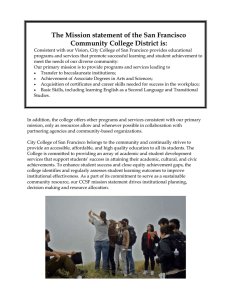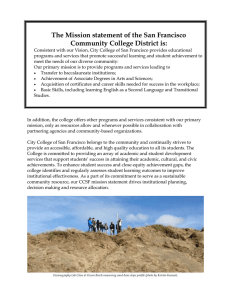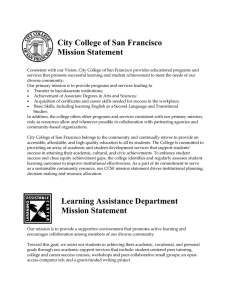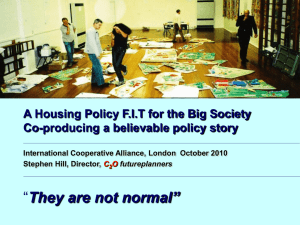Meet a mechanical engineer Teaching the built environment
advertisement
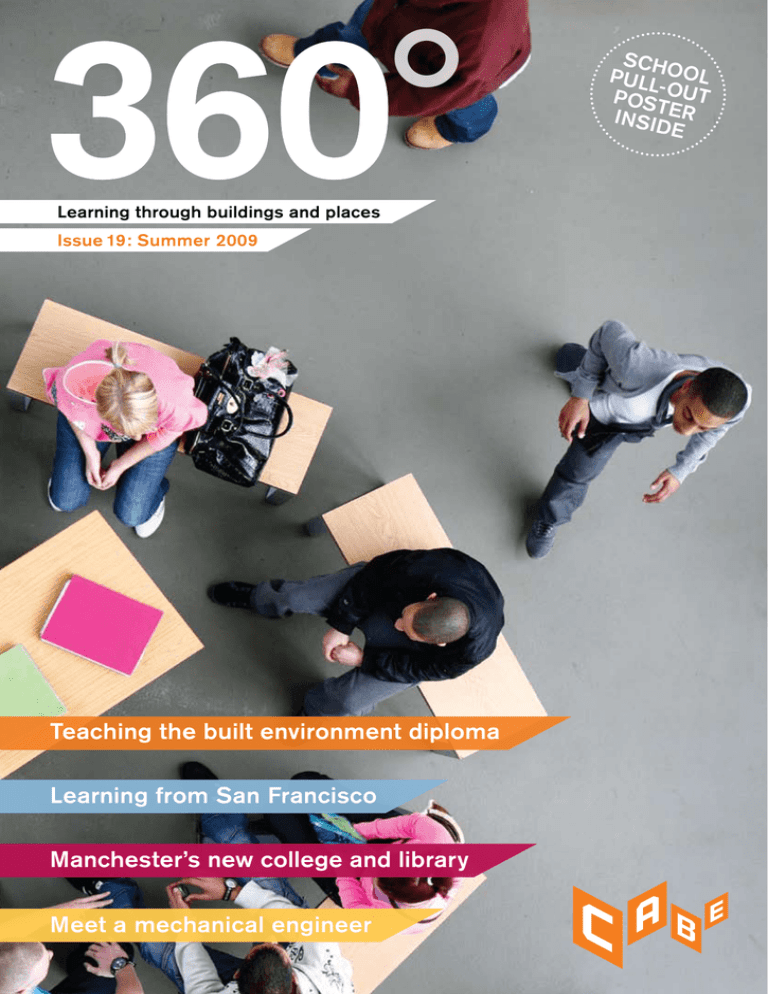
360 360° Learning through buildings and places Issue 19: Summer 2009 Teaching the built environment diploma Learning from San Francisco Manchester’s new college and library Meet a mechanical engineer SCHO PULL OL POST-OUT INSIDER E Summer spotlight° Hello and welcome to the summer edition of 360˚ – the leading magazine for education on architecture and the built environment. As you’ll see my first few months in post have been a busy time for CABE’s education team. At the end of March, we held a very successful Engaging Places event at the Victoria & Albert Museum with culture secretary Andy Burnham. After his speech he was grilled by some of the students who took part – which, as you’ll read, led to some interesting answers. The new diploma in construction and the built environment is under way and CABE has been bringing together key players to discuss the next steps. You’ll see from the report there are some great ideas around, but also some issues to be resolved. As you read this 100,000 students across the country will be taking part in Green Day. I believe Green Day is a great way to help make schools more sustainable and all of us more environmentally aware, so we’ll be providing a full report in the next edition – watch this space! 06 Policy and practice Teaching the new diploma Centre pull-out poster Designing a building that works 08 Looking towards San Francisco 10 Education at the architecture centres 12 CABE education resources This spring saw CABE team up with north London’s Wren Academy and young architecture practice Harry Dobbs Design for a project exploring housing. A group of year 7 students took part in activities that encouraged them to think about their personal space, their family base and their community place. “We introduced students to the space most familiar to them – their bedroom – asking them to measure and draw plans of the space,” teacher Ronnie Smylie explained. “Later sessions explored the home and then the wider neighbourhood. At each stage, the students reviewed the set-up. Later they had to think about the most important elements in different spaces, including a tree house, a tower block and an island.” “I believe Green Day is a great way to help make schools more sustainable and all of us more environmentally aware” Anne Diack Head of education 360˚ Issue 19 The project worked around a busy school timetable as it linked up with a range of subjects and developed students’ personal learning and thinking skills. Student feedback showed that they appreciated the variety of resources used and that group work allowed them to be more adventurous when developing ideas. Throughout the summer term Wren Academy is replicating the project and delivering it independently with the rest of the year 7 humanities classes. CABE will share the lessons from the project so that others can use it in the next academic year. For further information please contact Laura Broderick, education advisor at CABE, email lbroderick@cabe.org.uk Left and above © CABE Broderick We also feature a BSF think tank held by Kent Architecture Centre and Sittingbourne Community College, a project in which architects working with the Wren Academy inspire school students to consider My space, my base, my place (see opposite) and work from the Architectural Foundation of San Francisco. There’s our usual round-up of news from the architecture centres and, on our pull-out poster, Richard Walder, a mechanical engineer, explains why his job is so fascinating. My space, my base, my place 04 News Time to engage 360° 03 News° Left © A&M Photography Limited “I learnt a lot of things at Kensington Palace, making the film had to be the best part” Tariq Aimey (right) took part in the Engaging Places project ‘Telling tales at the palace’ Future schools think tank Sittingbourne Community College has used its CABE education grant to investigate what makes an ideal learning and teaching environment. Working with Kent Architecture Centre, 18 students were introduced to key design concepts and vocabulary to help them express their opinions and ideas more easily. They visited new schools in the region, before putting together a report and presentation on how new or refurbished buildings can be designed to promote more effective learning. Video footage and photos from the site visits, and drawings and models of classroom spaces and furniture illustrating innovative ideas, have been collected. These are being used to aid a series of student-led workshops that will engage a wider group of students in the project. If you would like to be updated with news of future CABE education grants, sign up to our network www.cabe.org. uk/education/network 04 Discovering Places 2009 As part of the programme of cultural activity leading up to London 2012, Discovering Places, a Cultural Olympiad project being delivered by CABE, Heritage Link and Natural England, will host an open weekend in or around the Olympic site in Stratford each year up until the Games. This year’s open weekend is planned to take place on Saturday 25 July at the Greenway, a six-mile foot and cycle path that runs through east London from Hackney Wick to the Royal Docks. The path follows the line of Bazelgette’s Northern Outfall Sewer. As it is elevated above the surrounding city, it gives fantastic views over east London and the Olympic site. Visitors on the day will be able to get close to the Olympic park developments, learn about the local natural, historical and contemporary environments and enjoy a range of events and activities along the Greenway route. To keep up to date with the plans as they develop go to www.cabe.org.uk/ london-2012/ospace Pupils from Barmby-on-theMarsh primary school in Yorkshire presented their ‘maximising learning space’ project at the Engaging Places launch event. Working with East Riding of Yorkshire School Improvement Service, 24 key stage 2 students designed a summer house in the school grounds that would function as a classroom, playroom, tearoom on garden party day, cricket pavilion and ticket office. The aim of the project was to develop a sense of social responsibility and foster a sense of ownership in the students. The whole school contributed their ideas about what the summer house would be used for, and the key stage 2 students researched garden design and garden buildings, from ancient ruins to follies. They then each made a model of a summer house they thought would best cater for the school and importantly the local community. 360˚ Issue 19 All other images © Alys Tomlinson Making the most of learning spaces Time to engage Culture secretary Andy Burnham joined CABE and English Heritage in March at London’s V&A museum for ‘Time to engage’ – a celebration of best practice projects from the new Engaging Places network. The event brought teachers, students and learning providers together to share the 13 partnership projects developed in the 2008/09 academic year. Presenting to a packed auditorium, teachers and students used film, photographic presentations and an exhibition to tell their story. Mr Burnham stressed the importance of using neighbourhoods and local experts to bring subjects to life. “Engaging Places gives every young person the chance to feel a part of all the amazing architecture and heritage with which this country is blessed”. During an on-stage interview, students from Graveney School in Tooting, south London, asked Mr Burnham about his favourite building. He praised St Martin-in-the-Fields church in Trafalgar Square and the Royal Liver Building in Liverpool for their beauty, but top of his list was Goodison Park – home of his beloved Everton Football Club! His most memorable moment while at school was campaigning for a cricket pitch on the school grounds – that pitch is still used at his school today. Details of all the projects can be found at www.engagingplaces. org.uk/network If you are a teacher or learning provider who would like to get involved contact Hannah Lake hlake@cabe.org.uk Have you used a CABE education resource as the basis for a project or lesson with young people? Would you like to see them included here or on our website? If so please email education@cabe.org.uk 05 Policy and practice° Qualification themes and levels Diplomatic efforts The construction and the built environment (CBE) diploma is one of five pilot diplomas launched by DCSF in 2008 as part of the 14-19 education reforms. What opportunities does the new diploma offer to teachers and students? And, after its first academic year of operation, what are the remaining challenges? Laura Broderick reports Diplomas are available at a range of academic levels and aim to help students to progress towards skilled jobs, further education and university. While there is still a great deal of classroom based learning, the new construction and the built environment (CBE) diploma offers students the chance to learn in a variety of settings and through a mixture of academic and practical activities. Forty four consortia (delivery partnerships of schools, colleges, training providers and employers) offered the diploma in September 2008. For teachers in those areas, it required creating new lesson plans, organising site visits, engaging employers and balancing practical activities with core curriculum content. 06 As a pilot diploma, the practical application has inevitably faced teething troubles. To help teachers and organisations delivering the diploma, CABE brought together representatives from built environment and policy-setting organisations, schools, and colleges in March to debate the design strand of the CBE diploma. Broader concerns emerged than teaching and learning about design. High on the list was the need for accurate marketing of the diploma so that students started the course with realistic expectations of the academic content. Students had a vision of the term ‘construction’ but expectations of learning about the ‘built environment’ were less clear. That perception problem © Michele Turriani All other images © Tanya Harris David Bell, director of qualifications and policy for Asset Skills, the sector skills council covering housing, property and planning, explains: “The CBE is not only a qualification – it’s a highquality learning experience and programme of applied learning in which students explore the built environment and the impact it has on communities.” By 2011 CBE diplomas will be available in 17 different subjects. Diplomas can be taken at three levels, starting in year 10 or 12: · Level 1 – Foundation (equivalent to five GCSEs at grades D to G) · Level 2 – Higher (equivalent to seven GCSEs at grades A* to C) · Level 3 – Advanced (equivalent to three and a half A-levels). The three compulsory course themes within the diploma are: · Design: learn how the built environment is designed and constructed, how it affects people and communities, and how history, politics and economics affect it. · Create: develop a range of skills and knowledge needed in different industries – for example, using tools and understanding modern construction methods and materials. · Value: analyse the need for good management and continuous maintenance, and understand the importance of good design, workmanship and teamwork. Alongside acquiring sector skills and knowledge, students study maths, English and ICT. Students have the opportunity to develop their own project and attend work experience for at least 10 days. 360˚ Issue 19 could also influence the maledominated take up – in Bristol, for instance, there are no girls at all on the course. year we’re going to take a more holistic creative approach, using a local site as a case study for project work.” “Students have the opportunity to develop their own project and attend work experience for at least 10 days” If you are a CBE tutor and would like to discuss your experience of delivering the diploma or to share good practice, please contact Laura Broderick lbroderick@cabe.org.uk Tutors explained that while they regard the diploma as high quality, these issues still need to be resolved. Day-to-day lesson plans and resources would also help to make it a success. Many of those involved are planning some changes next year. For instance, Jo Bishop, CBE programme co-ordinator for City of Bristol College, said: “This year we decided to split the units between tutors but next Further reading www.cbediploma.co.uk www.dcsf.gov.uk/14-19 www.qca.org.uk/diploma www.teachernet.gov.uk/ diplomas www.engagingplaces.org.uk Public space resource CABE, keen to support this new diploma, worked with the V&A+RIBA Architecture Partnership to engage diploma groups in the design of public space. Using Exhibition Road in London as an example of a changing streetscape, a class from Kent participated in a workshop at the V&A, and a group from Bristol explored possibilities for a local street. Student feedback showed that they welcomed the opportunity to come up with their own ideas. “It laid a foundation for design work to be approached with enthusiasm,” one tutor commented. 07 Looking towards° San Francisco © iStockphoto.com / Jim Jurica buildings around it.” Their favourite element of the design was the clever use of the roof for a multi-level garden area. California learning Do you want to inspire your students with an unusual competition? The Architectural Foundation of San Francisco did just that. Its design competition for high school students has run for 40 years, with many winners going on to be successful as architects, design professionals or engineers. Anne Diack reports Wong kept the brief open, with instructions to address sustainability, the features particular to the site – including historical aspects, and to think about how people would use the space. learned from the process. One of the judges, Dave Stockdale of the Centre for Urban Education about Sustainable Agriculture, found the competition prompted ideas about communication. “This was an opportunity to explore the ways in which we can better interface with the public,” he said. The overall winner in 2008 was Kayla Hidalgo of Lowell High School in San Francisco. The judges thought her design “addressed the condition of the site and created an outdoor space that related to the Looking at the site, you can see the challenge. You’ll also see what a rich learning opportunity this kind of work presents – whatever subject you’re teaching and however old your students. You can see the winning designs on the AFSF website www.afsf.org We’ve all seen films shot in San Francisco. Cable cars, hills, the Bay and the Golden Gate bridge, the light, the fog – iconic images of one of the most visually interesting cities in the world. There are many significant buildings, too. Set up in 1990, the Architectural Foundation of San Francisco (AFSF) is a non-profit educational body that aims to inspire schoolchildren about the city and help them understand the impact architecture and design has on their environment and lives. “We seek to share with children the passion and pride that those who shape the physical environment have for San Francisco,” says Alan R. Sandler, the foundation’s executive director. Projects include the Build San Francisco Institute, a half-day high school programme for students interested in design, construction, engineering and architecture. Run with the San Francisco Unified School District and more than two dozen major San Francisco firms, Build San Francisco is open to all high school students in the district. Each student who joins the programme works with a mentor from a major San Francisco architecture, engineering, design, construction or interior design company or public body. High school credits are awarded for the courses. The foundation also runs a summer school institute for high school students to develop their own design skills through animation, drawing, photography, video, CAD and 3D modelling, enabling them to create a portfolio for college or job applications. Find out more at www.afsf.org Back in England At CABE, we’re planning to run a design competition for English schools. We are asking for input from teachers to help shape the brief. If you have any ideas, please email education@cabe. org.uk The resulting designs were wide ranging, and the models of a very high standard – the students were clearly learning a lot by taking part. But they weren’t the only people who 08 Below © Axel Mueller Right © AFSF In 2008 Bolan Wong, a former winner of the student design competition run by the Architectural Foundation of San Francisco (ASAF) and now at Gensler, a leading architectural firm, challenged present-day students to design a building for the Centre for Sustainable Agriculture on the city’s waterfront. The objectives of the brief were to: · increase the participants awareness of the relationships between space, human scale and function · encourage them to start identifying problems and benefits in planning and designing for specific uses · push them to apply their analytical skills and creative problem solving · give them experience in communicating planning and design ideas through drawing and models. The challenge set for 2009 was to design a building that will serve as a museum, archive and learning centre about the rich film history of the city’s Bay area. The project site is on the Bay on the edge of a stretch of water bounded by two piers. The challenge was tough – what kind of building would best serve the purpose and still exploit the advantages of the location? The students were given a map of the area and the site and some photos to help them understand the context. Architectural Foundation of San Francisco 360˚ Issue 19 09 Education at the architecture centres° The lives of buildings A pattern of places Urban Vision North Staffordshire (UVNS) is running a series of events during 2009 to engage young people in an exploration of the built environment in North Staffordshire at both the macro scale of town planning and the micro scale of detail, decoration and materials. The students will think about their experience of where they live, and how this experience has changed over time. They will also consider their impact on the local urban environment compared to the urban environment’s impact on them. The end of each project will culminate in a public exhibition at the School of Art in Burslem. If you would like to find out how your school could get involved contact Fiona Waddle fiona.waddle@uvns.org Open House has joined forces with English Heritage to create a series of exciting architecture events over the weekend 26–28 June, as part of the ‘Story of London’ festival. Building Lives/The Lives of Buildings will illustrate the links between historic and contemporary architecture, revealing why some buildings fail and others remain popular. The programme will also look forward, with experts explaining how they are working to make buildings more sustainable. Evergreen day 10 in Torpoint to consider the crossing between Devon and Cornwall. Almost a quarter of Torpoint’s students use the Torpoint Ferry twice a day to cross from their homes in Devon to school in Cornwall. But will this still be possible in 50 years’ time? Students looked at designs from the past, and compared these to futuristic alternatives. So far over 500 students have taken part, and ACD&C is asking another 300 students the question again this June. If you are based in Devon or Cornwall and are interested in running a similar day at your school email Marie Sellars, education and projects manager, marie.sellars@ acdandc.org.uk. The new edition of CABE’s Green Day activity kit is now available. To order a copy go to www. cabe.org.uk/publications 360˚ Issue 19 For details of your local architecture and built environment centre, as well as news, activities, events and programmes in your region, go to www.architecturecentre.net Look to the future, look east! Back to school Fundamental’s ‘legacy now youth panel’ has continued its work with the team at EDAW, masterplanning the Olympic Park after the 2012 Games. The young people have submitted a formal response to the planning documents and have created a soundscape to accompany a fly-through of the proposed developments. On 17 July the panel will host a multi-media event for other young people about the plans for east London. If you would like to bring a group of students along to the event which starts at 2pm at the Ocean in Hackney please contact Julie Creffield at Fundamental on 020 8471 7929 or email julie@fundamental.uk.net. The legacy now youth panel is a dedicated group of young people from the five Olympic host boroughs. The programme was commissioned and funded by the London Development Agency in partnership with London’s five 2012 host boroughs. For more information visit www.legacynow.co.uk © Fundamental The Architecture Centre Devon and Cornwall (ACD&C) used the Green Day activity book in March to support two ‘education for sustainable development’ days at Torpoint Community School, East Cornwall. The day consisted of a range of school-wide cross-curricular activities, including learning how to make an emergency shelter in case of an environmental disaster and making alternative fuels using a lemonade bottle. To coincide with the 150th anniversary of Brunel’s Royal Albert Bridge, ACD&C also worked with students Above and right © UVNS For more information visit www.london.gov.uk/ storyoflondon The Architecture Centre Network co-ordinates, supports and advances the work of architecture and built environment centres. Solent Centre for Architecture + Design is running a series of workshops for teachers throughout the year in and around the Hampshire area. A built environment workshop takes place over two half days, providing a complete introduction to the built environment – exploring why it is important, how it can be used and how to embed it into teaching practice. The workshop is very handson and considers individual teachers’ schemes of work, enabling teachers to develop content for particular subject areas or age groups. All attendees receive a comprehensive workshop manual and toolkit to keep. The half-day ‘SketchUp’ courses are suitable for any teacher interested in using this software in their school and they cater for beginners and more advanced users. SketchUp is a free to download software that allows you to easily create 3D images. Solent Centre is also developing workshops for teachers on the natural environment and on sustainability and landscape. These courses will be offered during academic year 2009–10. Visit www.solentcentre.org. uk/education to register and for more details as they become available. If you would like to be added to the Solent Centre mailing list please contact mark@solentcentre.org.uk 11 °063 Inspiring young people to get more out of buildings and spaces CABE’s education work aims to ensure that young people understand the value of well-designed buildings and spaces. Our ambition is to nurture a generation of confident and demanding citizens playing an active role in improving villages, towns and cities. CABE education resources All our education resources are available to download free of charge at www.cabe. org.uk/teachingresources, in some cases publications are also available to order in hard copy. All the resources identify curriculum links, learning objectives and contain suggestions for interactive activities. Engaging Places www.engagingplaces.org.uk Supporting teaching and learning through buildings and places. The website is packed with ideas and information, including best practice case studies and teaching resources for all key stages. To sign up to the newsletter, go to the website home page. Key stage 2 Neighbourhood journeys: making the ordinary extraordinary Using the local built environment as a context for learning in and around the school. Our street: learning to see This revised cross-curricular teachers’ guide provides numerous ideas and suggestions for making a visual analysis of a street, and includes a CD ROM of images. Key stages 3 and 4 Green Day Green Day is a one-day event for schools about climate change and the built environment. Sign up online to CABE’s network of teachers, educators and other professionals to get free copies of 360 magazine mailed to you direct www.cabe.org.uk/360 Getting out there: art and design local safari guide Five ideas to support teachers in using local buildings, places and spaces for teaching. Key stage 4 Where will I live? www.geography.org.uk/ projects/wherewillilive A GCSE geography resource exploring housing issues, developed in partnership with the Geographical Association. Key stage 5 Making better places www.makingbetterplaces.org.uk A geography resource for analysing the design and structure of places and developing design solutions. Material developed by Joint Centre for Urban Design (JCUD) at Oxford Brookes and supported by CABE. Designed by Together Printed by Seacourt on Revive Uncoated 100% recycled Cover image © Alys Tomlinson Commission for Architecture and the Built Environment 1 Kemble Street London WC2B 4AN T 020 7070 6700 F 020 7070 6777 E education@cabe.org.uk www.cabe.org.uk
